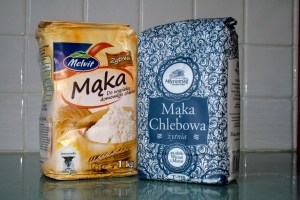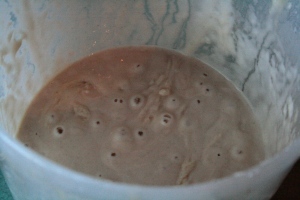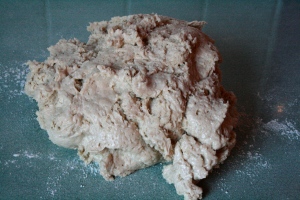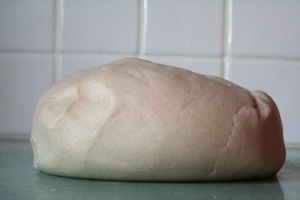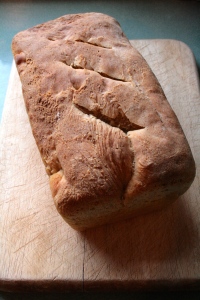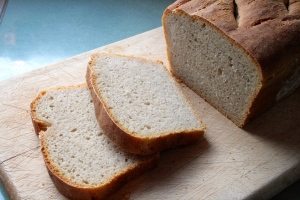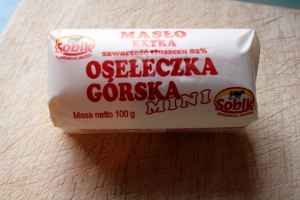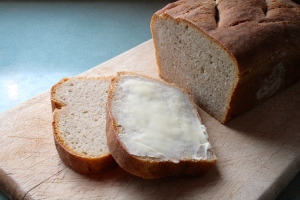Poland is an important grain growing and exporting country, and Polish shops stock a much wider range of flours than your average supermarket. Wheat varieties are broadly the same as those grown throughout the EU, depending on their suitability for region and climate.
Maka pzenna means wheat flour, and like most European varieties, it’s graded in terms of the proportion of protein it contains. For cakes, you want Tortowa, though unlike UK-style self-raising flour it doesn’t contain raising agents. Lukusowa is the equivalent of plain flour, Chlebowa is strong bread-making flour, Sitkowa, with 15% protein, is very strong flour, and Rasowa is wholemeal. Zytnia is rye flour, and oswiana, oat flour. For spelt flour, look for “orkisz/orkiszowy” on the pack. Don’t do what I did, and buy two bags of rye flour by mistake – there are so many brands to choose from that I developed flour bewilderment.
Polish bread, chleb, is a massive subject. With sour/fermented flavours so popular in Poland, with pickles and sauerkraut, sour cream and even sour rye soup, there’s a lot of sourdough bread on sale. Most of it village-this and country-that. But while the taste is good, the texture and freshness can be variable. There are several big-scale Polish bakeries in London, including the Cracow Bakery www.cracowbakery.co.uk (in Enfield, though the label on the small Cracow Bakery rye loaf I bought said Purfleet), Polish Village Bread in Hayes ( www.polishvillagebread.co.uk ) and the Polish Bakery in Wembley ( www.thepolishbakery.co.uk ).
They distribute country-wide, so the staff of life has to be built to last. One recommended to me last time I Polski Sklepped was a small spelt-flour loaf: will try and report at a future date. (The rye loaf, by the way, was fine but not earth-shattering: it was made with wheat flour and a rye sourdough starter, with a dob of caramel to make it cosmetically peasanty. The sour taste was there, but the texture was slightly leathery.)
The virtue of Polski Sklep bread is that it’s much cheaper than the equivalent you’ll buy in your local artisan bakery ( we have one of these nearby, but at £2.75, their rye boule is an occasional treat ), or from a farmer’s market, where between £4-6 for some sort of rustic loaf is not unusual. It won’t beat a Chorleywood Process loaf on price, but it won’t cost much more, offers a bit more substance if you choose carefully and should taste better.
If you want to try to make your own sourdough bread, read Jeffrey Steingarten
( http://tinyurl.com/lwwx65m ) on the topic first: or, indeed, listen to the Fall’s M5#1: http://tinyurl.com/o7pceoc.
The devil makes work for idle hands…. and in the 21st century, home-made sourdough bread has become a tiresomely worthy worldwide cult that has fomented a million websites. While I figure the noble scone is worth ten minutes of my time, I’d rather leave breadmaking to the professionals. Toiling over starters and kneading and proving, with or without mechanical aids, is just too Medieval. The notion that bread was always better in the past is a fallacy, anyway. Google “ergot poisoning” and you develop a sudden gratitude towards the EU grain prairie farmers and their nice, modern fungicides.
But as I had two stupid bags of rye flour sitting around, I thought I’d better try it, as Thomas Beecham ( http://tinyurl.com/onnkrt4 ) suggests, just the once.
The Sklep loaves I’d bought were made with rye sourdough starter and with white bread flour, but with the Zytnia invasion taking over the kitchen, industrial quantities of rye flour were called for. I checked a few online sourdough baking forums for proportions and techniques, but there are termagants out there who demand standards of suffering and commitment to The Starter so intense they make Terence Fletcher ( Whiplash www.whiplashmovie.co.uk – JK Simmons for Best Supporting Actor next week! ) look like Bambi.
So I retreated to the haven of the beginner’s sourdough bread recipe at The Kitchn, ( http://tinyurl.com/mh9b9vj ), substituting two generous cups of Młynomag ( http://www.mlynomag.pl ) rye flour for two of white.
The starter roared off obligingly, and given the way it sucked in its daily doses of water and flour and gained mass I worried that a black hole was forming on top of the fridge. Once it was ready to use it had the consistency of condensed milk and smelled like powerful silage.
( As I write, it’s still still brooding away up there. Can’t decide whether just to chuck it, or try sourdough pancakes at the weekend, then chuck it. Will move to a family vote. )
Making the recipe was simple enough – it uses dried yeast to help the rise, while I used a modest slice of drożdże, below – fresh yeast, another item a good Polski Sklep will have in the chiller cabinet.
But with work to do, the sun shining and kids to entertain at half-term, hovering over the dough with a timer was out of the question, so it got slapped about…
bunged in a bowl and abandoned for the best part of a day.
It rose, twice, and when baked, surprisingly turned out not to be a weapons-grade brick.
It even tasted good. The crust belied its gnarled appearance by being pleasantly chewy and the inside crumb had an even, well-risen texture, not heavy or soggy.
The sourdough wasn’t overwhelmingly stackyardy, allowing the nutty rye flour flavour to shine through. With a generous application of very nice Polish butter – Sobik, from Poland’s southern highlands, 59p for 100g…
… it all tasted very artisan.
Not doing it again, though.

